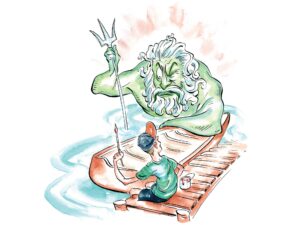
The old Forester pontoon boat had been rotting away on a South Carolina farm for 15 years. Nature had taken over, with weeds and bushes growing up around it in the field where, other than to stop bullets fired during its occasional use for target practice, it sat dormant. Still, its owners, Will and Melissa Merritt, were not quite ready to give it up, as the wreck was once a family boat. Given its sentimental value, they decided they’d rather spend their money on a restoration instead of on something new. They had an idea of what they wanted but no idea how to start. So how do you bring a boat like this back from the dead? You call Edwin McCain.
Song of Restoration
If the name sounds familiar, it’s because you’ve likely heard his voice at multiple wedding receptions in the late ’90s. The Greenville, South Carolina-based singer/songwriter penned ballads, such as “I’ll Be” and “I Could Not Ask for More,” that were top-40 hits. He still makes music — and restores boats. Thanks to Animal Planet, McCain’s longtime hobby became a full-fledged business enterprise called Boats Have Souls — and a TV series called Flipping Ships. In the show, McCain and crew seek out seemingly irreparable boats, like the old Forester, and bring them back to life.
McCain, 46, says he’s always dabbled in boats. But his restoration inspiration came about six years ago when he found an 18-foot 1986 Chris-Craft Scorpion in a warehouse. He saw potential beyond the bad carpet and upholstery.
“I didn’t have a boat, and I couldn’t afford a new one,” he explained. “My boys were little at the time, maybe 3 and 4. I figured if I could fix this boat up, they could do whatever they wanted in it, and I wouldn’t be stressed about it.”
He stripped the boat, pumped out the bad gas, and changed the spark plugs and oil. Soon he had a running boat. McCain says the experience lit a fire in him. He realized the country was full of abandoned boats that could be brought back to life, and he undertook his next project: a 50-foot Hatteras.
“I bought it because, hey, the Scorpion was easy enough,” he says with a laugh. “I bit off more than I could chew. But I had to do it. Hatteras is such an American story; it’s what I want to believe about myself. You have this guy that’s an avid fisherman — not an expert, but someone who wants to build a big boat of fiberglass. His friends thought he was off his rocker, but he asked the right people.”
That guy was visionary Will Slane, and he turned to naval architect Jack Hargrave to design a new breed of fishing boat. McCain says he found the story deeply inspiring.
“When you decide to save a boat, it doesn’t matter if you don’t know how to do that,” he says. “You make mistakes, you learn.”

Admittedly not an expert, McCain also chose to ask the right people for help. He first turned to his best friend, Robbie, who is a master mechanic. McCain also pulled in Howie, the detail guy; Doug, the rock star of paint and body work; and Wayne, the white-bearded, colorful demolition man.
“Robbie and I had been doing projects together for years,” McCain says. “Howie worked next door to me in the warehouse, and Doug had a shop in the complex, doing custom restorations and paint work on cars. I’d known Wayne for more than 20 years, and I’d often said he needed his own show.”
In a twist of fate, McCain decided the Hatteras restoration might make a good film project. He took the concept to a Los Angeles production company, and it liked the idea. So did Animal Planet.
Flipping Ships made its debut on Animal Planet in April 2015, and, overnight, McCain became more than a musician, singer and songwriter. He became the boat whisperer.
“Every boat is beautiful to someone,” he says. “And it needs to be with that person. You might think a boat is too far gone, but we’ll go all the way down to the hull and rebuild the boat the way you want it. Like it’s part of the family, because it is.”

Some offbeat “family members” included a 1970s Yukon Delta boat, as well as a midcentury Sea King runabout, which Hootie & the Blowfish frontman Darius Rucker hoped to sell in a charity auction to support MUSC Children’s Hospital in Charleston, South Carolina. And there was a rare Airstream truck camper, which the team converted into a floating family retreat (incorporating an airboat barge from Louisiana).
“The Airstream was probably my favorite because it was so kooky,” McCain notes. “If you’ve got good bones, you can rebuild it.”
On the old pontoon boat, they did just that.

Old Forester, New Life
In the second episode, the team rescued that derelict Forester pontoon from its South Carolina pasture. The boat’s owner, Will Merritt, played football for the Clemson University Tigers from 1998 to 2001; he also worked as the team’s color analyst for 12 years. To put it mildly, he’s a big Clemson fan, and the team was determined to transform the sad hulk into a floating tailgate hot spot — a “sailgater.”
McCain says they began to see the diamond in the rough once they cleared out the junk, stripped the railings and side panels, and trashed the old console. The pontoons and the platform were still solid. Doug’s job was to fix the dings and dents, including the long scrape McCain inadvertently added to one hull when he towed the trailer around the warehouse. He used a slide hammer to pop out the dents, ground and smoothed out the scratches, and then primed and painted the pontoons with a custom orange he created from several toners.
Next, the team scraped off the old carpet glue and laid in new carpet. (Field green so that this boat would be a reflection of the Clemson spirit in every possible way.) They fabricated aluminum railings in the distinctive shape of Memorial Stadium, more popularly known as Death Valley. They added an upper deck and a large scoreboard/TV, and transformed reclaimed stadium seats into fishing chairs. They built a new console to accommodate the steering wheel, throttle and electronics; saved the couch frames and reupholstered all seating with Clemson colors and embroidered tiger paws; and even added flat-screen TVs to the backs of the couches so fellow boaters and paddlers, even swimmers, could catch a glimpse of the game.

Racing to meet their deadline (the final home game of the season), the team hung the engine; installed the custom galley with its Sedona By Lynx grill, sink, and refrigerator/freezer/ice maker; mounted the TVs and side panels; connected the steering cable; and painted field lines on the floor. Finishing touches included Tigers pillows and throws, barbecue tools, and tailgating items, Tigers flags, and even an autographed football from the coach.
On delivery day, the Merritts were beside themselves. Will Merritt observed that the finished product demonstrated McCain’s instinctive understanding of how a boat should reflect the needs of a family, creating a one-of-a-kind experience on the water.

Every Boat is Beautiful
For each episode, McCain and his team of “gear heads on a mission” have 15 days from the discovery of the subject boat to the completion of the project, including shooting. Fortunately, they’re able to take more time with the nontelevised projects that are more in tune with your reality.
Some are fairly straightforward. Recently, a customer brought in a Boston Whaler filled with worms, leaves and rotten wood. Mice had gotten cozy in the engine.
“We cleaned it down to the hull, and that boat was as solid as a rock,” McCain says. “Even the engine ended up fine!”
McCain said he’s always eager to see what the next adventure brings.
“I’ll be excited about what I find in this nasty, dirty boat,” he says, laughing. “It’s like, what the hell is that?”
This country is littered with boats like the Scorpion that McCain found years ago, and the old Forester left forgotten in a field. They’re left outside because something broke, the owners never got around to fixing it, and now they think that perhaps the boat isn’t worth fixing anymore. But they’re wrong. As you get deeper into those adventures in restoration, you realize that all boats do have souls. Really.









